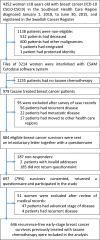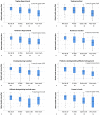Impact of persistent peripheral neuropathy on health-related quality of life among early-stage breast cancer survivors: a population-based cross-sectional study
- PMID: 35941422
- PMCID: PMC9464756
- DOI: 10.1007/s10549-022-06670-9
Impact of persistent peripheral neuropathy on health-related quality of life among early-stage breast cancer survivors: a population-based cross-sectional study
Abstract
Background: We explored the impact of persistent sensory and motor taxane-induced peripheral neuropathy (TIPN) symptoms on health-related quality of life (HRQL) among early-stage breast cancer survivors (ESBCS).
Methods: A population-based cohort of 884 residual-free ESBCS received a postal questionnaire, including the EORTC chemotherapy-induced PN (CIPN20) and the EORTC QLQ-C30 instruments. Mean scores of QLQ-C30 scales among ESBCS with and without TIPN were calculated and adjusted for confounding factors (age, lifestyle factors, co-morbidities; linear regression analyses). Interpretation of QLQ-C30 results were based on guidelines.
Results: Response rate was 79%, and 646 survivors were included in the analysis. In median, 3.6 (1.5-7.3) years had elapsed post-taxane treatment. All TIPN symptoms had a significant impact on global QoL, which worsened with increased severity of TIPN. Between 29.5% and 93.3% of ESBCS with moderate-severe TIPN reported a clinical important impairment of functioning and personal finances, 64.3-85.7% reporting "difficulty walking because of foot drop," and 53.1-81.3% reporting "problems standing/walking because of difficulty feeling ground under feet" had impaired functioning/finances. The difference in mean scores between affected and non-affected survivors was highest for "numbness in toes/feet" and "difficulty walking because of foot drop." Moderate-severe "difficulty climbing stairs or getting out of chair because of weakness of legs" and "problems standing/walking because of difficulty feeling ground under feet" were associated with the largest clinically important differences on all scales.
Conclusion: Persistent sensory and motor TIPN is associated with clinically relevant impairment of global QoL, functioning, and personal finances among ESBCS, which increased with level of TIPN severity.
Keywords: Adjuvant therapy; Breast cancer survivorship; CIPN20; Chemotherapy; Chemotherapy-Induced Peripheral Neuropathy CIPN; Financial toxicity; Functional health; Health-related quality of life; QLQ-C30; Quality of life; Survivorship; Taxane; Taxane-induced peripheral neuropathy.
© 2022. The Author(s).
Conflict of interest statement
The authors have no relevant financial or non-financial interests to disclose.
Figures





References
-
- Roine E, Sintonen H, Kellokumpu-Lehtinen PL, Penttinen H, Utriainen M, Vehmanen L, Huovinen R, Kautiainen H, Nikander R, Blomqvist C, Hakamies-Blomqvist L, Saarto T. Long-term health-related quality of life of breast cancer survivors remains impaired compared to the age-matched general population especially in young women. Results from the prospective controlled BREX exercise study. Breast. 2021;59:110–116. doi: 10.1016/j.breast.2021.06.012. - DOI - PMC - PubMed
MeSH terms
Substances
Grants and funding
LinkOut - more resources
Full Text Sources
Medical

